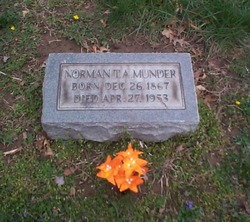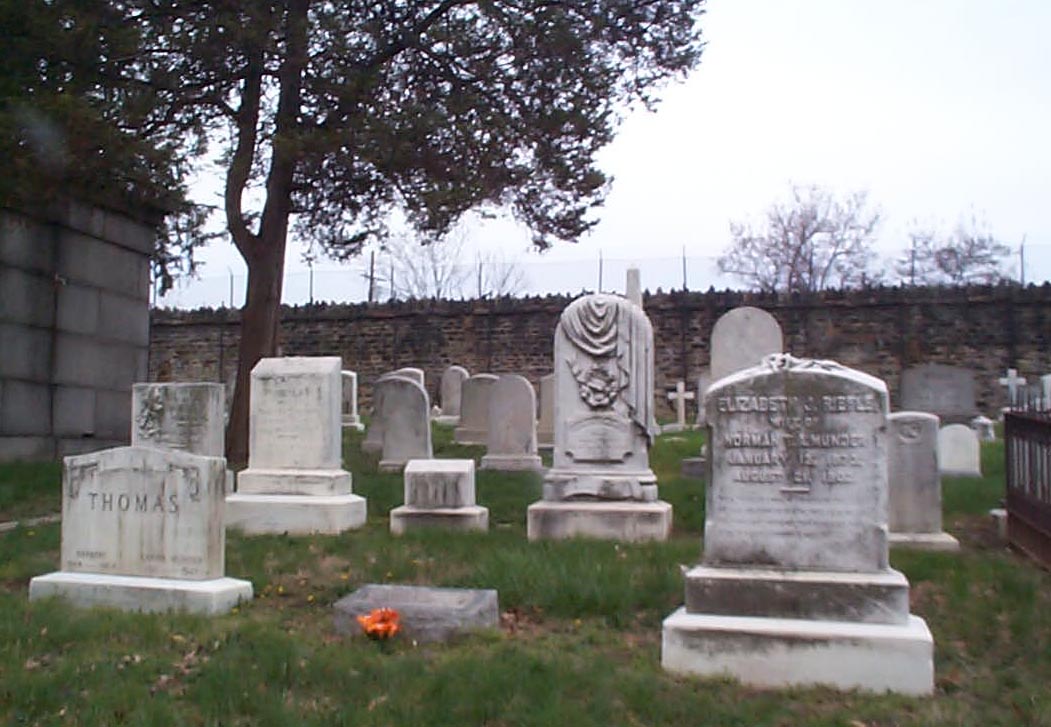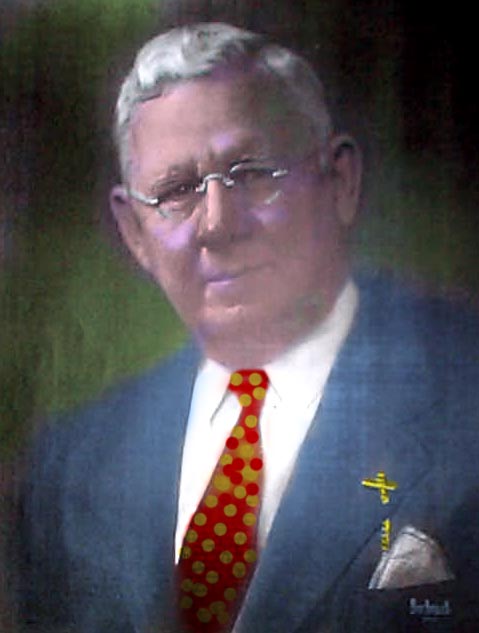Born in a home on Lombard Street, he was the son of Charles F. Munder, a confectioner, and Priscilla Price. He was the brother to Charles, Wilmer and sister, Carrie.
At age 7, Norman and his brothers bought an old printing press on sale and went into the printing business, first making visiting cards, delivered by a toy wagon pulled by a billy goat.
In 1878, they were able to open their first shop (the Munder Brothers) on Baltimore Street, because their mother took them to buy their first real printing press with modern equipment and it ran faithfully until the 1904 Baltimore Fire. But in using the press, Norman lost two fingertips. He was not discouraged for he was drawn by the love of the work. They printed bill heads, letter paper and envelopes, pamphlets, always updated B&O timetables, even large orders like labels. So overwhelmed were they that the brothers hired four skilled journeymen printers.
Meanwhile, Norman attended School No. 1 on Greene and Fayette; later attending Friends School and Baltimore City College on Howard Street.
Norman began to think in terms of beauty in printing and the new Md. Casualty Co. gave him orders in which he could exercise his concepts. In 1915, his company won a gold medal in the Panama-Pacific Exposition for the best example of book printing and fine pictures. The business grew and by 1916, they moved to the Candler Bldg. on Water Street, now with 8 employees and 6 treadle presses, each turning out 1,000 impressions an hour. With the development of the gas engine, their foot-operated presses were replaced.
After brother Charles' death, the firm moved to E. Fayette, opposite the Court House. They now had 33 workers and 11 presses. Their specialty was to "do what others could not." Printing commissions came from the Library of Congress, Boston Mus. of Fine Arts, J.P. Morgan, John D. Rockefeller and other institutions.
In a 1920 Printing exhibition, he won a "gold" award - the highest available. And in the same year, he co-authored the "Report of First Meeting and Dinner, Tendered to the Apprentices by the Typothetae of Washington, D.C." In 1925, he wrote "Advertising of Truth." He also printed for advertising firms such as Alexander Brothers, and was a contributor to "PM" magazine. In October 1937, "PM" gave a birthday party in his honor.
Norman was a pioneer in many features of printing. His achievements added new words to printer's vocabulary, new styles of type to printing equipment, new methods of plate work; new varieties of ink, and new combinations of paper. Norman's printed books and books on printing, broadsides, maps, pamphlets, reproduced etchings, and other ephemera is well documented on-line and in the Pratt. The Maryland Room at the Enoch Pratt Library holds over 10 boxes of his prints.
The "Baltimore Sun" gave him many tributes including a tribute regarding the decision of who should print L.C. Wroth's manuscript "A History of Printing in Colonial Maryland" (a definitive study of the origins of letterpress craftsmanship), in the finest traditions of 200 years? -- the job being given to the printing house of Norman T.A. Munder.
"...Mr. Munder printed more books than anyone has counted...it was never in his nature to treat any book cavalierly. It was his habit to regard a manuscript as an achievement and an opportunity for artistic embellishment. Mr. Munder went on to undertake commissions for millionaires, art collectors, libraries and museums. His reproductions and type arrangements were marvels of taste and clarity; his attention to the finer points of binding and paper was no less meticulous."
After retirement from active business in 1931, the Library of Congress asked him to reproduce the Declaration of Independence and the Constitution of the United States using 30-yr. old photos to work with. Though he thought it sacrilege to use photos, he restored the beauty of the original printing and the reproductions are stored at the courthouse in Sandusky, Ohio.
Norman was a beloved uncle of the Riefle family. He married Elizabeth (Bessie) Riefle and they had two daughters - but Bessie died in delivering the second girl. Later, Norman married Jerusha Goodloe of Afton, VA, and in 1948, they lived at 2335 Linden Avenue.
Norman was a member of the Bibliophile Society of Boston, the National Arts Club of NY, the Merchants Club of Baltimore, the American Institute of Graphic Arts, the American Federation of Arts, the Art Center of NY, the Associated Advertising Clubs of the World, the Typothetae of the US, the Baltimore Lodge 210l, and the Grolier Club of NY, to name a few.
By late middle life, he grew quite deaf. Towards the end of his life, he lived in a Catonsville retirement home.
_____________________________
See also the Tercentenary History of Maryland; Enoch Pratt Library; the Baltimore Museum of Art; Wikipedia.com; "A Man Named Munder" biography by L.J. Hawley, 1929; and DeadFred.com.
Born in a home on Lombard Street, he was the son of Charles F. Munder, a confectioner, and Priscilla Price. He was the brother to Charles, Wilmer and sister, Carrie.
At age 7, Norman and his brothers bought an old printing press on sale and went into the printing business, first making visiting cards, delivered by a toy wagon pulled by a billy goat.
In 1878, they were able to open their first shop (the Munder Brothers) on Baltimore Street, because their mother took them to buy their first real printing press with modern equipment and it ran faithfully until the 1904 Baltimore Fire. But in using the press, Norman lost two fingertips. He was not discouraged for he was drawn by the love of the work. They printed bill heads, letter paper and envelopes, pamphlets, always updated B&O timetables, even large orders like labels. So overwhelmed were they that the brothers hired four skilled journeymen printers.
Meanwhile, Norman attended School No. 1 on Greene and Fayette; later attending Friends School and Baltimore City College on Howard Street.
Norman began to think in terms of beauty in printing and the new Md. Casualty Co. gave him orders in which he could exercise his concepts. In 1915, his company won a gold medal in the Panama-Pacific Exposition for the best example of book printing and fine pictures. The business grew and by 1916, they moved to the Candler Bldg. on Water Street, now with 8 employees and 6 treadle presses, each turning out 1,000 impressions an hour. With the development of the gas engine, their foot-operated presses were replaced.
After brother Charles' death, the firm moved to E. Fayette, opposite the Court House. They now had 33 workers and 11 presses. Their specialty was to "do what others could not." Printing commissions came from the Library of Congress, Boston Mus. of Fine Arts, J.P. Morgan, John D. Rockefeller and other institutions.
In a 1920 Printing exhibition, he won a "gold" award - the highest available. And in the same year, he co-authored the "Report of First Meeting and Dinner, Tendered to the Apprentices by the Typothetae of Washington, D.C." In 1925, he wrote "Advertising of Truth." He also printed for advertising firms such as Alexander Brothers, and was a contributor to "PM" magazine. In October 1937, "PM" gave a birthday party in his honor.
Norman was a pioneer in many features of printing. His achievements added new words to printer's vocabulary, new styles of type to printing equipment, new methods of plate work; new varieties of ink, and new combinations of paper. Norman's printed books and books on printing, broadsides, maps, pamphlets, reproduced etchings, and other ephemera is well documented on-line and in the Pratt. The Maryland Room at the Enoch Pratt Library holds over 10 boxes of his prints.
The "Baltimore Sun" gave him many tributes including a tribute regarding the decision of who should print L.C. Wroth's manuscript "A History of Printing in Colonial Maryland" (a definitive study of the origins of letterpress craftsmanship), in the finest traditions of 200 years? -- the job being given to the printing house of Norman T.A. Munder.
"...Mr. Munder printed more books than anyone has counted...it was never in his nature to treat any book cavalierly. It was his habit to regard a manuscript as an achievement and an opportunity for artistic embellishment. Mr. Munder went on to undertake commissions for millionaires, art collectors, libraries and museums. His reproductions and type arrangements were marvels of taste and clarity; his attention to the finer points of binding and paper was no less meticulous."
After retirement from active business in 1931, the Library of Congress asked him to reproduce the Declaration of Independence and the Constitution of the United States using 30-yr. old photos to work with. Though he thought it sacrilege to use photos, he restored the beauty of the original printing and the reproductions are stored at the courthouse in Sandusky, Ohio.
Norman was a beloved uncle of the Riefle family. He married Elizabeth (Bessie) Riefle and they had two daughters - but Bessie died in delivering the second girl. Later, Norman married Jerusha Goodloe of Afton, VA, and in 1948, they lived at 2335 Linden Avenue.
Norman was a member of the Bibliophile Society of Boston, the National Arts Club of NY, the Merchants Club of Baltimore, the American Institute of Graphic Arts, the American Federation of Arts, the Art Center of NY, the Associated Advertising Clubs of the World, the Typothetae of the US, the Baltimore Lodge 210l, and the Grolier Club of NY, to name a few.
By late middle life, he grew quite deaf. Towards the end of his life, he lived in a Catonsville retirement home.
_____________________________
See also the Tercentenary History of Maryland; Enoch Pratt Library; the Baltimore Museum of Art; Wikipedia.com; "A Man Named Munder" biography by L.J. Hawley, 1929; and DeadFred.com.











